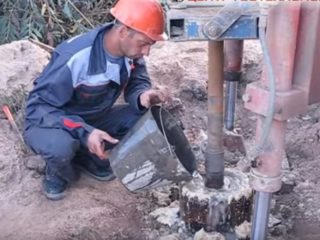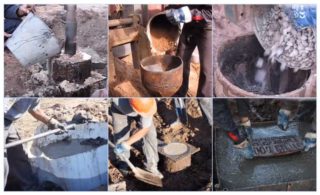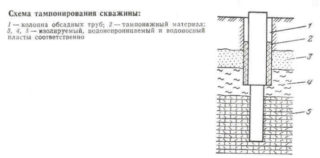Well plugging or plugging is a set of measures aimed at protecting drilling hydraulic structures, for example, artesian wells, from biological and chemical pollution of the aquifer, destruction of concrete casing rings. When conducting an autonomous water supply system, it is artesian wells that are most often constructed, and they need regular backfilling.
Purpose and definition of well plugging

Plugging is a technological process, the main task of which is to block and separate the aquifer with a protective cushion. This protective "barrier" is made of cement mortar. The space between the earthen shaft and the water intake is subject to cementing. In the form of a swab, molten plastic or clay is often used with auxiliary construction ingredients.
The main purpose of the procedure is to prevent possible contamination of the aquifer and protect it from pathogens entering it. Tamping is carried out in the following cases:
- Decrease in the quality of well water with insufficient isolation of the aquifer.
- Deformation or destruction of concrete casing rings.
- No need to operate the water intake point.
- Prevention of mixing of different water horizons, for example, with a high concentration of metals and salts with fresh water, etc.
- Detection of geological and / or technical faults.
- Prevention of contamination of the source, provided that drilling and construction were carried out with gross violations.
- Reduced productivity of the water intake point and the inability to create a new one.
Well plugging is recommended when looking for new sources, as well as to prevent water from entering it.
Types and technology of holding
- Constant. The filling of the gap with cement mortar is characterized.
- Temporary. The procedure is accompanied by the fact that the gap is filled with clay mixtures.
The first method is designed to operate the well shaft for a long time. For example, the average service life of an artesian well reaches 50 years or more. The second is used when a new well is required to test and remove specific gaps between aquifers or the formations themselves.
The temporary type of plugging is also liquidation for sources of shallow depth with no pressure.
Backfill and liquidation technology

With the complete elimination of the source, cement slurry is poured into the mine - this reduces the likelihood of mixing of adjacent aquifers, and also strengthens the shaft.
There are different variations of cementing, the compositions used have significant differences. Which solution to give preference depends on the hydrogeological characteristics of the source.
The main building mixture is Portland cement. When mixed with water, a liquid solution is formed, which can be easily transported using a water pump. Within a short time, it becomes impenetrable and hard. The prepared mixture is poured into a mine working to a height of approximately three meters. Sand and gravel are also added to the grouting solution until a liquid state is obtained.If sliding of aquifers is observed, the gaps are filled with the solution, pouring between the pipes.
The grouting is carried out in a quality manner using a clay press. A column of clay is placed in the face with a tool for the column. This pillar is squeezed out using a water pump. The projectile is equipped with a number of holes for draining excess solution, they are also made to reduce pressure.
The plugging technology consists in filling the gaps between the column or pipe wall with a clay or cement mixture. Work is carried out at a depth where the aquifer lies. Bleach is also added to the solution for disinfection.
Advantages and disadvantages
The technological process is widespread, since it has a rather extensive list of advantages:
- Improving the sealing of the connecting seams of concrete casing rings and strengthening the structure as a whole.
- Implementation of additional waterproofing.
- Prevention of effluent and upper water penetration into the artesian well.
Of the shortcomings, it is worth noting the financial, physical and time costs. Experts recommend that the liquidation tamponing be trusted by professionals, since the procedure requires the use of special equipment and equipment. Protective grouting can be done independently.









